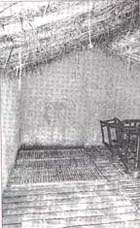Cheap storage for potatoes
 SCIENTISTS at the International Potato Centre's (CIP) regional division in Delhi have designed an on-farm facility for storing potatoes through the summer months, which is as good as a refrigerated store, and cheaper by far. Called the rustic evaporative cooled store, it is made of easily available material -- bricks, sand, mud, straw and bamboo or sticks.
SCIENTISTS at the International Potato Centre's (CIP) regional division in Delhi have designed an on-farm facility for storing potatoes through the summer months, which is as good as a refrigerated store, and cheaper by far. Called the rustic evaporative cooled store, it is made of easily available material -- bricks, sand, mud, straw and bamboo or sticks.
"The idea behind the new design is to help farmers store potatoes after they have been harvested, so that they can sell them later when prices rise," says Mahesh Upadhaya, CIP's regional director. Normally, potatoes can be stored for about 2 months before they begin to rot. The new facility allows storing upto 10 tonnes of tubers from March to mid-June.
As potatoes are a winter crop, they are usually stored through the summer, when the temperatures are high and the humidity low in most parts of the country.
Potatoes, like all living organisms, need oxygen to live. As they take up oxygen, they use up their stored starch, becoming skinnier and wrinkled in the process, fetching a lower price in the market. Respiration accounts for 40 to 60 per cent of the total weight lost, depending on how and when the potatoes are stored.
The new storage facility -- a large room with a thatched roof -- has several drains 22.5 cm deep running across the floor. These are half-filled with sand. Water is let into the drains which, when absorbed by the sand, reduces the temperature to as low as 180C when temperatures outside could are as high as 400C. The potatoes rest on a bamboo mesh placed above these wet drains. The store is designed to allow a constant flow of air through openings at the base.
CIP's scientists found that potatoes stored in the new facility lost as little weight as potatoes stored in conventional cold storage facilities. But Upadhaya points out that unlike the latter, potatoes cannot be stored in the new facility once the rains come. Four stores have been constructed at Modipuram in Uttar Pradesh and Deesa in Gujarat on a trial basis.
